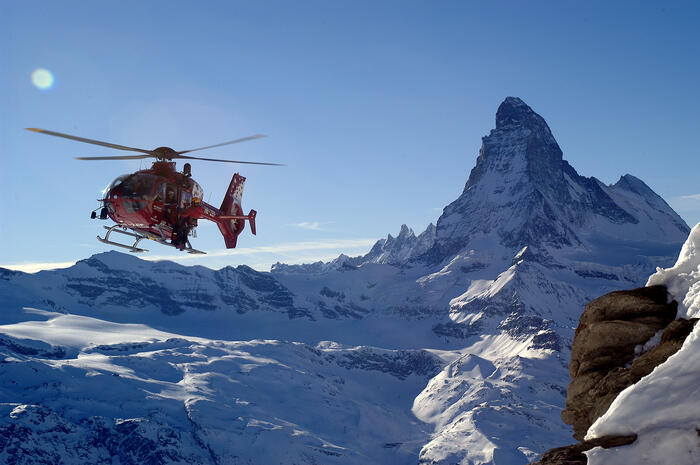
The “Heroism Award” is aviation’s most prestigious annual award worldwide. The forerunner of the men from Zermatt was Captain Sullenberger, who in 2009 made an emergency landing on the Hudson River in New York with a crippled Airbus A-320 carrying 150 passengers.
Best mountain rescuers in the world
Air Zermatt, the helicopter company that has been making flights from Zermatt since 1968, enjoys a global reputation for carrying out the toughest mountain rescues. The Air Zermatt pilots and their rescue specialists get practice with round flights, transport flights, heliskiing, search missions and rescues. The Air Zermatt pilots have vast experience and so a transfer of know-how exists between the pilots and mountain guides from Zermatt and their colleagues in Nepal. These regularly attend training courses in Switzerland and then complete their training in Nepal. With their work involving exchange with helicopter pilots from other nations, the aviation pioneers of Air Zermatt demonstrate that the mountaineering mecca of Zermatt also possesses a well-organized mountain rescue service. Daniel Aufdenblatten says: “After more than 40 years, the entire Air Zermatt team is still performing pioneering work.”
In April 2010, Daniel Aufdenblatten and Richard Lehner were staying in Nepal for a rescue training course. They received an emergency call and hurried to come to the aid of mountaineers, even though at that time it was not even certain that a rescue at such an altitude was possible.
Challenge to flying skill
The rescue took three attempts. Among other things, the pilot had to fly back to base camp because Richard Lehner suffered a lack of oxygen while suspended on the rescue line during the ten-minute approach flight to the accident site. The weather also refused to cooperate. But things finally worked out. Daniel Aufdenblatten: “As we approached the accident site, one of the injured climbers thought we were a hallucination – a wonderful experience.” Richard Lehner adds: “It’s extremely satisfying for me as a mountaineer when I can rescue people from a life-threatening situation.” The two saved three mountaineers, two Spanish and one Romanian, from the inevitability of an icy white grave on Annapurna. However, the return flight also demanded finely tuned flying skill. The helicopter with its extra load of severely injured climbers had to be flown safely back down to the valley from an altitude of 7000 metres. “Until then, helicopter rescues at those altitudes had been regarded as impossible. The Zermatt rescue station proved the opposite,” says Daniel Aufdenblatten, summing up the experience on Annapurna.
The two men from Zermatt are overjoyed to have once more been able to save human lives. And overjoyed, they hold the crystal-shaped award in their hands – also a superb symbol for Zermatt’s mountain world.
Facts & Figures
| Rescue | 29 April 2010 |
| Rescued persons | 2 mountaineers from Spain 1 mountaineer from Romania |
| Altitude base camp | 4200 metres (13700 feet) |
| Altitude of accident site | 7000 metres (23000 feet) |
| Flight time to injured persons | 10 minutes |
| Height gain on approach | 2800 metres (8800 feet) |
| Aircraft | Helicopter, Ecureuil AS350 B3 |
| Pilot | Daniel Aufdenblatten (35), Air Zermatt |
| Mountain rescuer | Richard Lehner (38), Alpin Center Zermatt, mountain and rescue specialist |